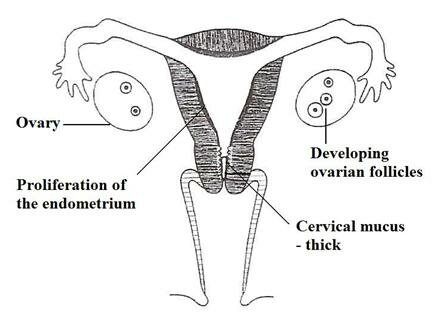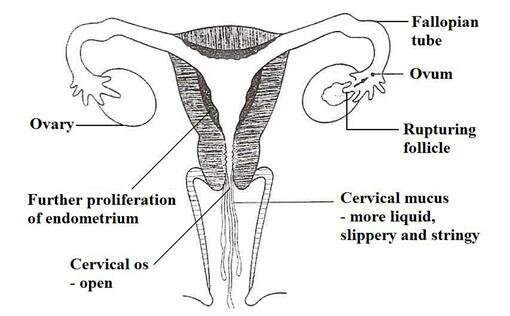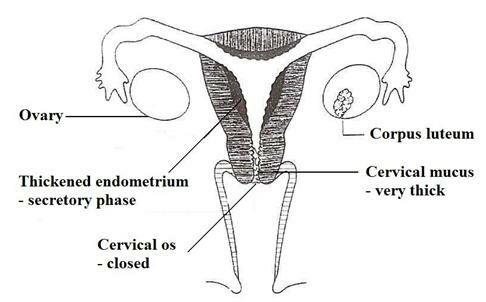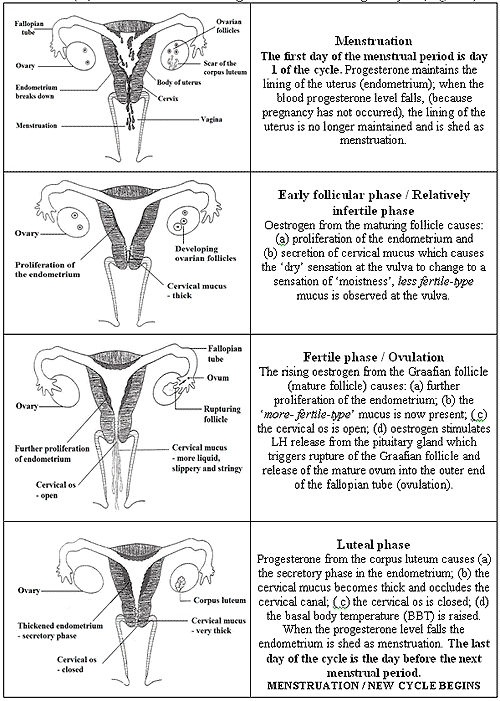During each menstrual cycle, a cycle of events occurs simultaneously in both the uterus and ovary termed the ‘uterine cycle’ and the ‘ovarian cycle’ respectively. During the ‘uterine cycle’ the endometrium, (lining of the womb) is prepared for a possible pregnancy. During the ‘ovarian cycle’ an immature ovum, (egg, primordial follicle) develops in the ovary and when it is mature it is released into the outer end of the fallopian tube at ovulation. Before ovulation the developing follicle secretes oestrogen. After ovulation the corpus luteum in the ovary secretes progesterone to maintain a possible pregnancy.
During the menstrual cycle changes also occur in the uterine cervix , i.e. the cells in the lining of the cervix secrete mucus, and the cervical os may be open or closed depending on whether the phase of the cycle is fertile or infertile. The woman can observe these events during the cycle as the hormones oestrogen and progesterone cause changes in the fertility indicators, (i.e. changes in cervical mucus, in basal body temperature and in the cervix itself) which allow her to identify when she is infertile or potentially fertile (fertility awareness).
Changes in the endometrium during the cycle, (uterine cycle):
These cyclical changes in the endometrium can be divided into three phases:
(i) menstrual phase
(ii) proliferative phase
(iii) secretory phase
- (i) Menstrual phase: (Figs.6-8, 6-12)
During the menstrual phase the superficial layer of the endometrium is discharged and this is called menstruation. Menstruation is the vaginal bleeding that occurs at the end of an ovulatory cycle when pregnancy has not occurred. Progesterone maintains the integrity of the endometrium and when pregnancy does not occur the progesterone level falls causing the endometrium to be shed as the menstrual period. The menstrual bleeding lasts from 3-5 days. The first day of the menstrual cycle is the first day of the period, and the last day of the menstrual cycle is the day before the next period.
- (ii) Proliferative phase: (Figs.6-9, 6-10, 6-12)
In the proliferative phase the endometrial cells in the uterus proliferate in preparation for a possible pregnancy. This growth is stimulated by oestrogen from the growing follicle (ovum, egg) in the ovary before ovulation causing the thickness of the endometrium to increase 3-5 fold.1 The proliferative phase of the endometrium corresponds to the follicular phase of the ovarian cycle, i.e. when the follicle (ovum, egg) is developing in the ovary.
- (iii) Secretory phase: (Figs.6-11, 6-12)
The secretory phase of the endometrium occurs after ovulation. In this phase the cells in the endometrium become more complex in preparation for implantation of the embryo. This is due to stimulation from progesterone which is secreted by the corpus luteum in the ovary. The secretory phase of the endometrium corresponds to the luteal phase of the ovarian cycle, when the corpus luteum is functioning in the ovary.
(B) Changes in the uterine cervix during the cycle – what the woman observes: (Figs. 6-9 to 6-12)
Depending on whether the phase of the cycle is fertile or infertile, the cells in the lining of the cervix secrete different types of mucus and the cervical os is either open or closed.
-
Infertile phases of cycle: Due to stimulation by progesterone in the infertile phases of the cycle the cells in the lining of the cervix secrete a thick mucus which prevents pregnancy occurring as this thick mucus occludes the cervical canal preventing the entry of sperm. There is no discharge of mucus from the vagina and the woman observes a sensation of ‘dryness’ at the vulva, (opening of the vagina). The cervical os is closed due to the effect of progesterone.
-
Fertile phase of the cycle: Due to stimulation by oestrogen in the fertile phase of the cycle the cervical cells secrete fertile-type mucus. The role of fertile-type mucus is to help achieve pregnancy. Fertile-type mucus (S mucus) is essential to achieve pregnancy as it aids sperm transport and survival. Cervical mucus is the most important sign of potential fertility (fertility indicator) as the discharge of mucus from the vagina can be observed by the woman and when she sees it she knows it indicates that the ovum is developing in the ovary and that she is now potentially fertile. The cervical mucus changes in quality and quantity during the mucus ‘build-up’ for the six days or so that lead up to ovulation, changing from a ‘less-fertile’ type mucus to a ‘more-fertile’ type mucus. This can be observed by the woman as a change in sensation at the vulva and a change in the appearance or texture of the mucus itself. In the fertile phase the cervical os is open due to the effect of oestrogen.
Changes in the ovary during the cycle (ovarian cycle) – what the woman observes:
The four phases of the ovarian cycle are the (i) menstrual phase, (ii) follicular phase, (iii) ovulation, (iv) luteal phase.
- Menstrual Phase (Figure 6-8): During menstruation at the beginning of the cycle, some immature follicles (ova, eggs) in the ovary begin to develop but they are not yet secreting oestrogen. The menstrual bleeding lasts from 3 -5 days.

Fig. 6-8; Menstruation: Menstruation is sloughing of the endometrium due to the drop in progesterone secondary to the demise of the corpus luteum. Day 1 of the period marks the beginning of a new cycle when the endometrium will be renewed in expectation of pregnancy in the new cycle. In the left ovary the atretic corpus luteum is shown as a ‘scar’. Some recruited follicles in the ovary are at the pre-antral stage of development.
-
Follicular phase: (Fig. 6-9):
In the first few days of the cycle, oestrogen and progesterone levels are low allowing FSH from the pituitary gland to stimulate a few follicles in the ovary to grow hence the term ‘follicular phase’. The developing follicles secrete oestrogen which (a) stimulates the endometrium to prepare for a possible pregnancy, and (b) oestrogen also stimulates the cells in the crypts of the cervix to secrete mucus. The cervical mucus discharge is observed by the woman as a change of sensation at the vulva from one of ‘dryness’ to one of ‘moistness’. The observation of mucus at the vulva marks the beginning of the fertile phase of the cycle, this is subject to the rules of the NFP Method used. The mucus initially is ‘thick and opaque’ in appearance and breaks on stretching between the fingers – which is characteristic of ‘less-fertile’ mucus. The presence of cervical mucus whether it is the ‘less-fertile’ or the ‘more-fertile’ type indicates potential fertility.

Fig. 6-9; Follicular phase: In the follicular phase, FSH from the pituitary stimulates growth of a number of follicles in the ovary. The developing follicles secrete oestrogen which causes proliferation of the endometrium and the secretion of mucus, from the glands in the crypts of the cervix. The woman perceives the presence of the cervical mucus as a sensation of moistness at the vulva or sees a vaginal mucus discharge.
-
Ovulation (Fig. 6-10)
Around Day 7 of the average 28 day cycle, (i.e. about 6 days before ovulation), one of the developing follicles becomes dominant and continues to grow (Graafian follicle), and the other developing follicles become atretic (atrophy). The high oestrogen output from the Graafian follicle stimulates luteinizing hormone (LH) secretion by the pituitary gland which lasts about 36 hours, (LH surge). LH triggers the rupture of the Graafian follicle and the release of the mature ovum (egg) into the outer end of the fallopian tube and this event is called ovulation. Ovulation occurs about 14 days before the next menstrual period. The high oestrogen level from the Graafian follicle stimulates the secretion of ‘more-fertile’ type mucus by the cervix. The woman observes that the sensation at the vulva (i.e. the opening of the vagina), changes from one of ‘moistness’ to one of ‘lubrication or slipperiness’ and that the appearance of the mucus at the vulva changes from the ‘less-fertile’ thick, opaquemucus, to the ‘more-fertile’ mucus which is clear,stretchy and looks like raw egg-white, (‘spinnbarkeit’ is the term used for the elasticity of mucus). The ‘more-fertile’ mucus transports and nourishes sperm and its presence is a sign of imminent ovulation. (Fig. 6-10).

Fig. 6-10; Ovulation: Around Day 7 of the average 28-day menstural cycle, one of the developing follicles becomes dominant and is called the Graafian follicle. The rising oestrogen level from the Graafian follicle causes the cervical mucus secretion to become more fluid and to have the characteristics of ‘more-fertile’ mucus as ovulation approaches. The woman perceives the presence of the ‘more-fertile’ mucus as a sensation of wetness or slipperiness at the vulva and/or sees a copious vaginal discharge of clear stretchy mucus. The cervical os is open due to the effect of oestrogen. The high oestrogen level stimulates the LH surge from the pituitary which triggers the rupture of the Graafian follicle and the release of the ovum into the outer end of the fallopian tube, i.e. ovulation.
-
Luteal phase (Fig. 6-11):
After ovulation, in the ovary the granulosa cells in the wall of the follicle become a small gland called the ‘corpus luteum’ which secretes both oestrogen and progesterone.2 Progesterone causes (a) the endometrial cells to become more tortuous and glycogen accumulates in the cells in preparation for a possible pregnancy and implantation of the embryo.1 (secretory phase of the endometrium), (b) Progesterone causes a decrease in the quantity and the elasticity of cervical mucus,1 i.e. it causes the oestrogenic mucus discharge to dry up. The woman observes a change in sensation at the vulva to one of dryness and there is no mucus discharge. Progesterone stimulates the secretion of gestogenic G mucus which occludes the cervical canal, (c) Progesterone causes a rise in the basal body temperature which is a sign that ovulation has occurred. The cervical os is closed due to the effect of progesterone.

Fig. 6-11; Luteal phase: After ovulation, during the luteal phase in the ovary the wall of the ruptured follicle with its granulosa cells becomes the corpus luteum which secretes progesterone. The progesterone from the corpus luteum prepares the endometrium for implantation of the embryo, (secretory phase of the endometrium). Progesterone stimulates the crypts in the cervix to secrete G mucus which is thick and occludes the cervical canal. The cervical os is closed due the effect of progesterone. The woman perceives a sensation of dryness at the vulva and there is no vaginal discharge. Progesterone raises basal body temperature and is the only fertility indicator that confirms that ovulation has occurred. See below for a ‘summary of changes in the uterus and ovary during the cycle’. (Fig. 6-12)
Fig. 6-12: Summary of changes in the uterus and ovary during the cycle.
References:
- Griffin JE, Ojeda SR;’Textbook of Endocrine Physiology 3rd Edition, 1996, pgs 171,172; Oxford University Press, ISBN 0-19-510755-1( pbk)
- Mansfield MJ, Emans SJ; ‘Anorexia nervosa, athletics,and amenorrhea’; Ped. Clinics of North America; Vol 36,No 3, June 1989, 533-549


